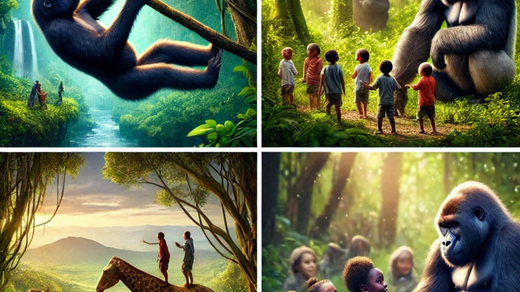Saving Baby Gorillas Like Hafez: A Guide to Action
The Plight of Baby Gorillas in the Wild
Hafez’s story sheds light on the challenges faced by baby gorillas in the wild. These innocent creatures often fall victim to poaching, habitat loss, and the illegal wildlife trade. The plight of baby gorillas is exacerbated by factors such as human encroachment, climate change, and disease outbreaks, putting their populations at risk of decline and extinction.
Despite the grim reality, there is hope for the future of baby gorillas. Conservation efforts led by dedicated organizations and individuals are working tirelessly to safeguard these majestic primates and their natural habitats. Through education, advocacy, research, and on-the-ground protection initiatives, progress is being made to secure a sustainable future for baby gorillas in the wild.
Why Hafez’s Story is a Call to Action
Hafez’s story serves as a poignant reminder of the harsh realities faced by baby gorillas in the wild. Rescued from the clutches of illegal wildlife trafficking at Istanbul Airport, his journey underscores the urgent need for stronger conservation measures to safeguard these vulnerable creatures. Hafez’s resilience in the face of adversity showcases the indomitable spirit of these majestic animals and compels us to take action to ensure their survival.
Understanding the Threats Facing Baby Gorillas
Baby gorillas face a myriad of threats in their natural habitats, with one of the key challenges being habitat loss due to deforestation, mining, and agriculture. As human populations expand and their demands on land increase, gorilla habitats are shrinking at an alarming rate. This loss of habitat not only reduces the available food sources for gorillas but also increases their vulnerability to conflicts with humans.
In addition to habitat loss, baby gorillas are also threatened by poaching and illegal wildlife trafficking, driven by the demand for gorilla meat, body parts, and live animals for the illegal pet trade. The exploitation of baby gorillas for commercial purposes not only decimates their populations but also disrupts the social structures within gorilla groups. Efforts to combat poaching and trafficking must be intensified to safeguard the future of baby gorillas in the wild.
The Importance of Conservation Efforts
Hafez, a rescued baby gorilla, serves as a powerful symbol of hope and resilience in the face of adversity. His rescue from illegal wildlife trafficking at Istanbul Airport sheds light on the harsh reality of smuggling and emphasizes the critical need for conservation efforts to protect vulnerable baby gorillas like him. Through Hafez’s journey to recovery, we witness the essential role played by enforcement teams, global awareness campaigns, and rehabilitation programs in safeguarding the well-being of baby gorillas and preserving the rich biodiversity of our planet.
The challenges faced by baby gorillas in the wild are numerous and complex, ranging from habitat destruction and poaching to diseases and climate change. Conservation efforts are crucial in addressing these threats and ensuring the survival of these endangered primates for future generations. By supporting conservation initiatives and raising awareness about the importance of protecting baby gorillas, we can make a meaningful impact in safeguarding their existence and promoting a sustainable coexistence between humans and wildlife.
How You Can Support Organizations Working to Save Baby Gorillas
To assist organizations dedicated to saving baby gorillas, consider making a donation. Financial contributions play a crucial role in funding critical conservation projects, anti-poaching efforts, and sanctuary maintenance. By supporting these organizations financially, you directly contribute to the protection and well-being of endangered gorilla populations.
Another way to support organizations working to save baby gorillas is by volunteering your time and skills. Many conservation groups offer volunteer opportunities that range from hands-on fieldwork to administrative tasks. By getting involved, you can make a tangible difference in the lives of baby gorillas and contribute to their long-term survival in the wild.
Volunteer Opportunities for Those Passionate About Gorilla Conservation
For those passionate about gorilla conservation, volunteering is a meaningful way to make a direct impact on the protection of these majestic animals. Many conservation organizations offer volunteer programs that involve tasks such as habitat monitoring, data collection, and community education initiatives. By dedicating your time and effort to these programs, you can contribute to the ongoing conservation efforts that are crucial for the survival of baby gorillas in the wild.
Volunteering in gorilla conservation not only allows you to support important fieldwork but also provides a unique opportunity to immerse yourself in the natural habitats of these incredible animals. Through hands-on experience and working alongside dedicated conservationists, volunteers play a crucial role in helping to safeguard gorilla populations and their habitats. Whether it’s assisting with research projects, participating in conservation activities, or raising awareness in local communities, volunteering offers a fulfilling way to be part of the solution in protecting baby gorillas and preserving their ecosystems.
Ways to Raise Awareness in Your Community
Raising awareness in your community about the plight of baby gorillas is crucial to garner support for their conservation. By organizing educational events at local schools, community centers, and wildlife sanctuaries, you can spread the word about the threats facing these majestic animals and the urgent need for protection. Sharing Hafez’s story and emphasizing the interconnectedness of wildlife conservation and global biodiversity can inspire individuals to take action in their own lives and communities.
Furthermore, utilizing social media platforms and creating digital campaigns can amplify the message of gorilla conservation to a wider audience. By sharing impactful visuals, informative articles, and calls to action, you can engage with a diverse range of individuals who may not have been previously aware of the challenges facing baby gorillas in the wild. Encouraging discussions, organizing virtual events, and collaborating with like-minded organizations can help spark meaningful conversations and drive collective efforts towards protecting these endangered creatures.
Tips for Responsible Tourism When Visiting Gorilla Habitats
When planning a visit to gorilla habitats, it is essential to prioritize the well-being of these magnificent creatures and their natural environment. Respect the guidelines set by conservation authorities and strictly adhere to rules such as maintaining a safe distance from the gorillas, refraining from feeding them, and never littering in their habitat. Remember that these are wild animals, and it is crucial to observe them in a way that minimizes any disturbance to their daily routines.
Additionally, consider the impact of your visit on the local community and environment. Choose eco-friendly accommodation, support local businesses, and engage in activities that promote conservation efforts in the region. By making conscious decisions during your trip, you can contribute positively to the preservation of gorilla habitats and the well-being of these vulnerable species.
How to Educate Others About the Need to Protect Baby Gorillas
To effectively educate others about the need to protect baby gorillas, it is essential to share impactful stories like that of Hafez. Hafez’s journey from being a victim of wildlife trafficking to becoming a symbol of hope exemplifies the challenges faced by these magnificent creatures in the wild. By highlighting such narratives, individuals can develop a deeper understanding of the threats faced by baby gorillas and the critical role of conservation efforts in safeguarding their future.
Additionally, leveraging visual aids such as documentaries, photographs, and virtual reality experiences can significantly enhance educational initiatives on gorilla protection. These tools not only provide a powerful visual representation of the challenges faced by baby gorillas but also evoke emotional responses that inspire action. Incorporating multimedia content into educational campaigns can effectively engage a wider audience and foster a sense of empathy and responsibility towards protecting these vulnerable animals.
The Impact of Individual Actions on the Future of Gorilla Populations
Protecting baby gorillas and ensuring the survival of their populations in the wild is a collective responsibility. Every individual action, no matter how small it may seem, contributes to the greater cause of conservation. Whether it is supporting reputable organizations, raising awareness within your community, or making sustainable choices in your daily life, each effort plays a crucial role in safeguarding the future of gorilla populations. It is through these individual actions that we can collectively make a difference and create a more sustainable future for these majestic creatures.
By educating others about the importance of protecting baby gorillas and their habitats, we can inspire a ripple effect of positive change. Sharing information, engaging in meaningful discussions, and dispelling misconceptions about gorillas can help cultivate a deeper understanding of the threats they face and the urgent need for conservation efforts. Through advocacy and outreach, individuals can amplify their impact and mobilize others to join in the mission of safeguarding the future of gorilla populations for generations to come.

